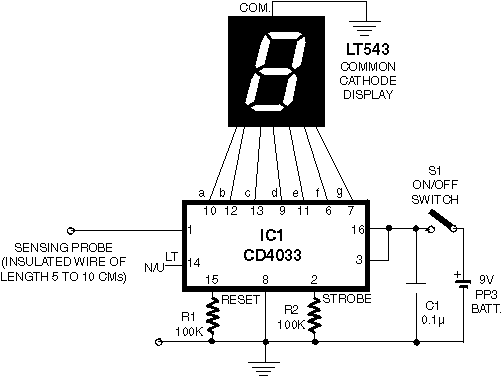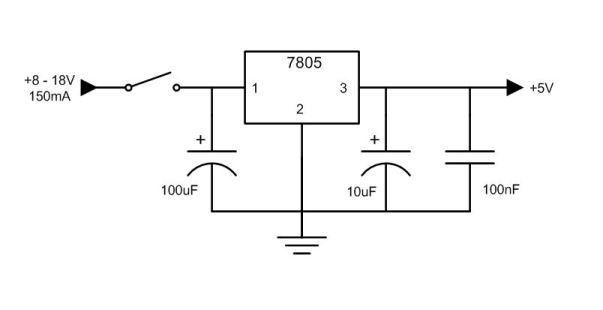
Mains Voltage Checker

This is a CMOS IC (CD4033) based circuit which can be used to detect presence of mains AC voltage without any electrical contact with the conductor carrying AC current/voltage. Thus it can be used to detect mains AC voltage without removing the insulation from the conductor. Just take it in the vicinity of the conductor and it would detect presence of AC voltage. If AC voltage is not present, the display would randomly show any digit (0 through 9) permanently. If mains supply is available in the conductor, the electric field would be induced into the sensing probe. Since IC used is CMOS type, its input impedance is extremely high and thus the induced voltage is sufficient to clock the counter IC. Thus display count advances rapidly from 0 to 9 and then repeats itself. This is the indication for presence of mains supply. Display stops advancing when the unit is taken away from the mains carrying conductor. For compactness, a 9-volt PP3 battery may be used for supply to the gadget.
The described circuit utilizes a CD4033 CMOS integrated circuit, which functions as a decade counter, to detect the presence of alternating current (AC) voltage without direct electrical contact with the conductor. The operation is based on the principle of capacitive coupling, where the sensing probe, positioned near the conductor, detects the electric field generated by the AC voltage.
When the sensing probe is brought into proximity with an AC-carrying conductor, an electric field is induced in the probe. The high input impedance of the CMOS IC ensures that even a small induced voltage can effectively trigger the clock input of the CD4033. This results in the counter advancing through its count sequence from 0 to 9, with the display updating rapidly to reflect this count. The rapid cycling of the displayed digits serves as an indication of the presence of mains AC voltage. In the absence of AC voltage, the display will show a random digit from 0 to 9, indicating that the circuit is not detecting any voltage.
For power supply, a compact 9-volt PP3 battery is recommended, providing sufficient voltage and current for the CMOS IC and ensuring portability of the device. The design emphasizes safety and ease of use, allowing users to detect AC voltage without the need for invasive contact with the electrical conductor, thus maintaining insulation integrity and reducing the risk of electric shock. The simplicity of the circuit design, combined with the effectiveness of the CD4033 in counting and displaying, makes this a practical solution for voltage detection in various applications.This is a CMOS IC (CD4033) based circuit which can be used to detect presence of mains AC voltage without any electrical contact with the conductor carrying AC current/voltage. Thus it can be used to detect mains AC voltage without removing the insulation from the conductor. Just take it in the vicinity of the conductor and it would detect presence of AC voltage. If AC voltage is not present, the display would randomly show any digit (0 through 9) permanently. If mains supply is available in the conductor, the electric field would be induced into the sensing probe. Since IC used is CMOS type, its input impedance is extremely high and thus the induced voltage is sufficient to clock the counter IC.
Thus display count advances rapidly from 0 to 9 and then repeats itself. This is the indication for presence of mains supply. Display stops advancing when the unit is taken away from the mains carrying conductor. For compactness, a 9-volt PP3 battery may be used for supply to the gadget. 🔗 External reference
The described circuit utilizes a CD4033 CMOS integrated circuit, which functions as a decade counter, to detect the presence of alternating current (AC) voltage without direct electrical contact with the conductor. The operation is based on the principle of capacitive coupling, where the sensing probe, positioned near the conductor, detects the electric field generated by the AC voltage.
When the sensing probe is brought into proximity with an AC-carrying conductor, an electric field is induced in the probe. The high input impedance of the CMOS IC ensures that even a small induced voltage can effectively trigger the clock input of the CD4033. This results in the counter advancing through its count sequence from 0 to 9, with the display updating rapidly to reflect this count. The rapid cycling of the displayed digits serves as an indication of the presence of mains AC voltage. In the absence of AC voltage, the display will show a random digit from 0 to 9, indicating that the circuit is not detecting any voltage.
For power supply, a compact 9-volt PP3 battery is recommended, providing sufficient voltage and current for the CMOS IC and ensuring portability of the device. The design emphasizes safety and ease of use, allowing users to detect AC voltage without the need for invasive contact with the electrical conductor, thus maintaining insulation integrity and reducing the risk of electric shock. The simplicity of the circuit design, combined with the effectiveness of the CD4033 in counting and displaying, makes this a practical solution for voltage detection in various applications.This is a CMOS IC (CD4033) based circuit which can be used to detect presence of mains AC voltage without any electrical contact with the conductor carrying AC current/voltage. Thus it can be used to detect mains AC voltage without removing the insulation from the conductor. Just take it in the vicinity of the conductor and it would detect presence of AC voltage. If AC voltage is not present, the display would randomly show any digit (0 through 9) permanently. If mains supply is available in the conductor, the electric field would be induced into the sensing probe. Since IC used is CMOS type, its input impedance is extremely high and thus the induced voltage is sufficient to clock the counter IC.
Thus display count advances rapidly from 0 to 9 and then repeats itself. This is the indication for presence of mains supply. Display stops advancing when the unit is taken away from the mains carrying conductor. For compactness, a 9-volt PP3 battery may be used for supply to the gadget. 🔗 External reference





